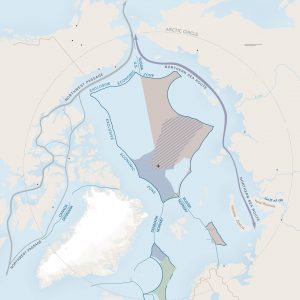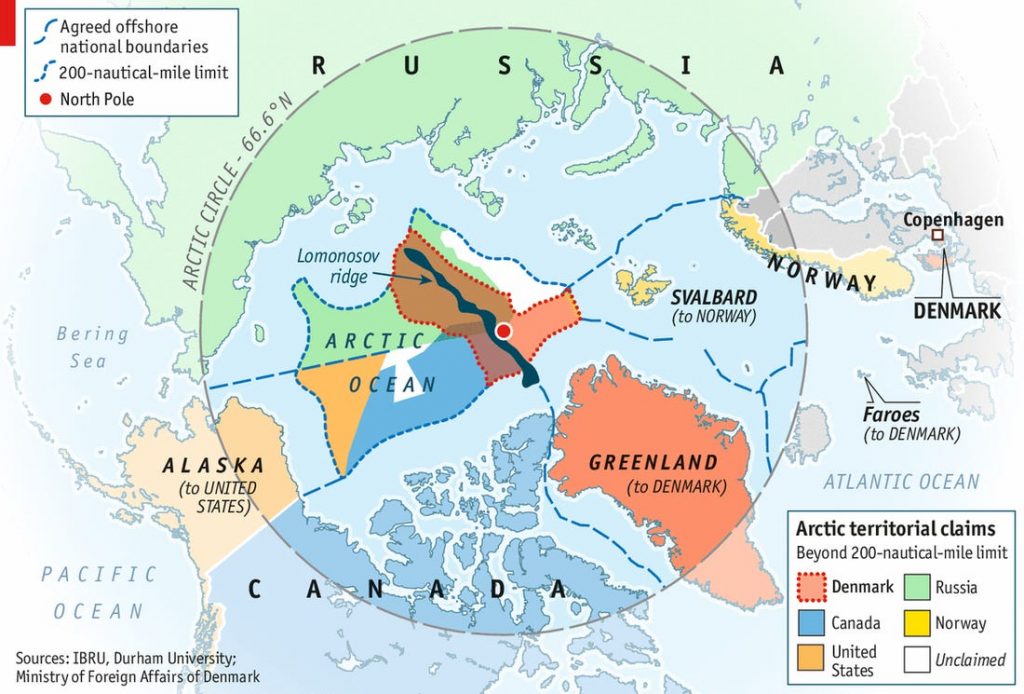“From Stettin in the Baltic to Trieste in the Adriatic, an iron curtain has descended across the continent.” — Winston Churchill, 1946
Churchill’s oration as Westminster College is considered one of the landmark moments announcing the beginning of the Cold War, a half-century global struggle between the United States and the Soviet Union which redefined history. While the Cold War ended three decades ago with the collapse of the Soviet Union, its history and legacy are increasingly relevant with the renewal of tensions between the West and a revanchist Russia which has re-emerged as a, if not peer, at a least capable competitor and adversary. While Russian influence and operations in the Donbas region and the Syrian Civil War have captured Western headlines, a less-noticed development is taking place at the proverbial top of the world, the Arctic Circle. With climate change and the inevitable continued thawing of polar regions, the Arctic Circle will likely emerge as an important new arena of geostrategic competition between the West and Russia, amplified by natural resource deposits and economic activity. Russia’s key infrastructural and military innovations in the region outpace the US’s capabilities and have the potential to pose real, long-term challenges to NATO and US security interests.
Part I. The Arctic Circle
Climate change and the warming of global temperatures have already led to sharp decreases in ice sheets in the Arctic Ocean and this trend is unlikely to slow. According to NASA, Arctic sea ice minimum coverage has decreased by an average of 12.85 percent per decade between 1981 and 2010. Simultaneously, annual total CO2 emissions have steadily increased with approximately 35 billion tons of emissions in 2017 alone. The Arctic Council, the leading intergovernmental forum promoting cooperation and sustainable development, announced that the Arctic would likely be completely ice-free at the end of the summer in 2040. With continued thawing, the “last frontier of human exploitation” will finally be open allowing for massive deposits of natural resources, most importantly, natural gas and petroleum, to be tapped and extracted.
The Arctic region has vast stores of natural gas and petroleum reserves in addition to various other natural resources. The US Geological Survey estimated that 90 billion barrels of oil, 1,69 trillion cubic feet of natural gas, and 44 billion barrels of other natural gas liquids lie underneath the Arctic ice sheets. These new reserves are worth an estimated $35 trillion. To put these figures into context, world consumption of crude oil was about 100 million barrels in 2019, and world natural gas consumption was about 132 billion cubic feet in 2017. In addition to wider access to a wealth of natural resources, Arctic thawing has also led to the possibility of greater economic activity through new shipping routes — most importantly, the Northern Sea Route.

The Northern Sea Route’s (NSR) main attractiveness is in the potential for drastically reduced shipping costs between Northern Europe and East Asia. It saves up to 40 percent of the sailing distance between the Netherlands and Japan compared to the traditional route through the Suez, and it could even become an alternative depending on weather conditions, regulations and transit fees according to economic analyses conducted by researchers at Erasmus University and the University of Southern Denmark. The potential profits and growing viability of the NSR are reflected in the amount of shipping, which has steadily increased from 7.5 million tons in 2016 to over 26 million tons in 2019. Furthermore, there is growing interest in the Arctic not only as a transit region but as a destination market in itself. A majority of the international community considers the NSR an international strait with open navigation as regulated by the United Nations Convention on the Law of the Sea (UNCLOS). While the current shipping volumes are still minute compared to the largest transit routes, the upward trend of growing interest by companies in both Asia and Europe and continued climate shifts, in combination with natural resource endowments, means that the Arctic region will likely continue to experience increased economic focus and activity.
The economic trends combined with the geostrategic importance of the Arctic, given the close proximity between northern Europe, Russia and North America, suggest that many countries will have a growing vested interest in the region. Canada, the Kingdom of Denmark (which includes Greenland and the Faroe Islands), Finland, Iceland, Norway, Russia, Sweden and the United States are all considered “Arctic countries” with some territorial claim in the region. Growing interest has materialized in multiple territorial disputes and competing claims to extend a country’s exclusive economic zone. While multiple countries have competing claims to the region, none have been as decisive and aggressive in establishing a foothold and investing in securing its economic and, potentially, military interests as Russia.

Part II. The Russian Federation
Russian activity in the Arctic aligns with an overall effort to claim the NSR as part of its internal waters and monitor and restrict international traffic through the route. Russia’s current activity focuses on the construction of installations and infrastructure on various islands on the northern coast oriented towards early-warning and defense. According to a report by CSIS, these installations include new airfields, radar installations, and border outposts. Other investments have been made in multilayered defense zones with the deployment of S-400 SAM systems and other electronic warfare and area denial capabilities. While the deployment of actual troop formations has been limited, the Northern Fleet, the Russian Navy’s primary fleet, is headquartered in Severomorsk and operates via multiple bases in the Murmansk region, about 125 miles north of the Arctic Circle. The fleet comprises an estimated 41 submarines, including 8 nuclear-powered ballistic missile submarines and an estimated 37 warships including Russia’s sole aircraft carrier along with guided-missile cruisers and anti-submarine warfare vessels. The presence of the Northern Fleet provides Russia with significant firepower and the ability to project power throughout the Arctic. While Russia’s existing deployments and construction efforts have signaled a shift towards the north, the most indicative actions have been through recent military exercises.
In 2019, Russia conducted two high-profile military exercises: Tsentr-19 in September and Grom-19 in October. Tsentr-19 was the largest multilateral strategic military exercise by Russia in its history, with over 128,000 personnel, more than 20,000 pieces of equipment and 600 aircraft of various types across 6 different areas of Russian territory. Most notably, more than 500 soldiers and 10 amphibious assault vehicles conducted drills on a remote island along the northern coast which Russian defense officials described as “‘serious testing of the battle capacities of the Arctic troops.’” The following month, in October, Russia executed its largest strategic nuclear forces exercise since the collapse of the Soviet Union, which involved the Northern Fleet and deployment of submarines into the GIUK gap, a naval transit point in the Northern Atlantic that is vital for Northern Europe’s access to the Atlantic. Considering Russia’s construction efforts and recent military exercises taking place in the Arctic Circle, it is clear that it views the Arctic as a vital operational region for its future.
Recent and ongoing developments have been part of a wider shift by the Russian military and President Vladimir Putin towards the Arctic. In July 2017, a new Russian Navy doctrine was approved, which highlighted the importance of the Arctic and sought to maintain Russia’s status as a major naval power, second only to the U.S. In part, the Northern Fleet would be bolstered with long-range conventional weapons and act to secure and deter aggression in what Russia considered its territorial waters. Additionally, in December 2019, Russia approved and published a long-term development plan of the NSR. Part of the plan includes boosting annual shipments to 80 million tons by 2024, developing infrastructure and building new ships to map and extract stores of natural resources in the region. While certain skeptics rightfully point to the gaps between stated goals and realistic capabilities, Russian activity and intent should still be concerning to the West, especially given the growing economic and geostrategic significance of the Arctic. In light of the magnitude of these concerns, current U.S. statements and activity have been disproportionate.
Part III. The United States of America
Until recently, U.S. policy towards the Arctic was not responsive towards the growing importance of the region nor were concrete steps taken in reaction to Russian activity. Prior to the Trump administration, Arctic policy was focused on international cooperation and scientific research with little investment in infrastructure or material capability, as evidenced by limited funding of the Coast Guard, the lead agency responsible for American Arctic operations and navigation. The Trump administration even considered defunding a new ice breaker intended to supplement the Coast Guard’s sole aging vessel in order to fund the border wall. Nonetheless, recently there are some hopeful signs, both domestically and internationally, that things are changing.
In 2018, the U.S. participated in Operation Trident Juncture conducted in Norway to experience operations in extreme weather conditions simulating Arctic conditions. Comprising 50,000 troops, 250 aircraft, 10,000 vehicles and 65 ships from partner countries, it was the largest wargame exercise since the end of the Cold War and demonstrated how seriously the West was taking Russia’s Arctic ambitions and activity. Recent developments in domestic policy also signal a shift in the U.S. Arctic policy.
For the fiscal year 2021, the Trump administration allocated $555 million to purchase a second ice breaker patrol vessel for the Coast Guard set to deploy in 2024. In addition, the Coast Guard itself is recognizing the need for greater capabilities to secure U.S. interests, with Admiral Karl Shultz stating that the service is considering acquiring more ice breakers into the 2020s. Recent statements by Secretary of State Michael Pompeo in May 2019 recognizing that the U.S. is “entering a new age of strategic engagement in the Arctic, complete with new threats to the Arctic and its real estate, and to all of our interests in that region” and indicated that the Trump administration was taking new measures both diplomatic and security-related as a response.
One of the most important shifts has been the Defense Department’s new Arctic strategy report published in June 2019. The new report is the most concrete evidence that the U.S. is pivoting to see the Arctic as a more relevant region in the era of strategic competition by acknowledging and criticizing Russia’s military build-up and attempts to dominate the NSR. Areas of focus include modernizing radar systems, increasing missile defense systems in cooperation with Canada through NORAD, adapting and deploying new communications technology capable of reliable communication and data coverage and continuing robust cooperation with the U.S. Coast Guard. In terms of building a credible deterrence, the strategy emphasizes “adapting existing capabilities and, where necessary, selectively acquiring new capabilities, combined with Arctic-tailored training, exercises and posture refinements.” Finally, the strategy calls for promoting international cooperation and strengthening multilateral support for a rules-based order in order to deter aggression and preserve freedom of navigation and overflight. Nevertheless, it is important to note that while doctrinal shifts are certainly occurring there is still a stark gap between statement and reality.
The FY 2021 military budget requested by DoD in February totaling $705 billion is a step in the right direction for bolstering U.S. capabilities in the Arctic but, as experts state, still falls short of adequately addressing the demands of international competition on U.S. policy in a holistic sense. The overall budget request is being criticized as short-sighted and narrowly-conceived in the DoD’s intentions and strategy through reverting to conventional and nuclear deterrence reminiscent of the Cold War to compete in a new era of strategic competition with changing technology, weapons and competitors.
Part IV. Conclusion
Given the natural resources and economic potential of the Arctic region, the United States must take firmer action in securing its national interests and bolstering operational capabilities in light of Russian moves to dominate the region. Unchallenged Russian activity would lead to an erosion of freedom of navigation through the NSR and lead to Russian domination of vast natural resource deposits. Recent events signal that the US is paying more attention to the Arctic but not enough, given the growing and future importance of the region.
Given current conditions and logistical challenges, prospects for direct future conflict are unlikely, at least in the short-term. “If it came to war in the Arctic, you’d really be fighting two enemies,” Brigadier General Mike Nixon said last year at the Yellowknife headquarters of Canada’s Joint Task Force North. “And the more dangerous of them would be the cold.” However, Russia and China have signaled their intent to continue investment and increase capabilities that challenge the United States and NATO’s capabilities to operate freely and safely. It would be short-sighted and mistaken to assume that international law and U.S. interests will remain secured without firmer, more decisive action in the form of increased funding for the Coast Guard and leveraging multilateral institutions to create international pressure to deter or, at the very least, demonstrate resistance to Russian ambitions. The Arctic is heating up and the U.S. must be prepared to address current and growing challenges.
Featured Image: Business Insider






Comments are closed.